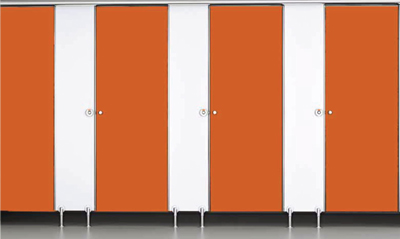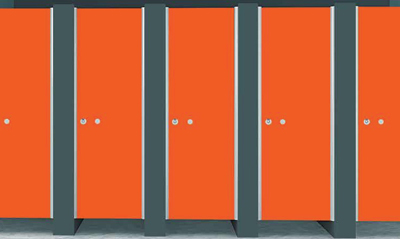When it comes to designing functional and aesthetically pleasing restroom facilities, one often overlooked but crucial aspect is the selection of appropriate toilet cubicle. These cubicles not only provide privacy but also contribute significantly to the overall ambiance and user experience. In this Blog, we delve into the world of toilet cubicles, exploring different types, materials, design considerations, installation processes, and maintenance tips to help you create the perfect restroom environment.

Types of Toilet Cubicles
Standard Cubicles
Standard toilet cubicles are the most commonly used option in public restrooms. They are typically constructed using durable materials such as plastic laminate or metal and are available in various sizes to accommodate different space requirements.
Accessible Cubicles
Accessible toilet cubicles are designed to meet the needs of individuals with disabilities. These cubicles are more spacious to allow for wheelchair access and often include additional features such as grab bars and emergency alarms to ensure safety and convenience.
High-end Cubicles
For upscale establishments where aesthetics are paramount, high-end toilet cubicles offer a perfect solution. These cubicles are crafted using premium materials such as solid wood or decorative laminates, and they can be customized to match the overall interior design scheme.
Materials Used in Toilet Cubicles
Toilet cubicles can be constructed using a variety of materials, each with its own set of advantages and considerations.
Wood
Wooden toilet cubicles exude a sense of warmth and elegance, making them ideal for high-end establishments. However, they require regular maintenance to prevent warping or water damage.
Metal
Metal toilet cubicles are known for their durability and resistance to moisture, making them suitable for high-traffic areas. They are also easy to clean and maintain, but they may lack the aesthetic appeal of other materials.
Plastic Laminate
Plastic laminate cubicles offer a versatile and cost-effective solution for restroom facilities. They are available in a wide range of colors and patterns, allowing for customization to match the overall decor.
Phenolic
Phenolic toilet cubicles are highly durable and resistant to water, scratches, and graffiti. They are commonly used in public restrooms where durability and hygiene are paramount.
Factors to Consider When Choosing Toilet Cubicles
When selecting toilet cubicles for your restroom facility, several factors should be taken into account to ensure optimal performance and user satisfaction.
Durability
Choose materials that can withstand frequent use and are resistant to moisture, scratches, and vandalism.
Maintenance
Consider the ease of cleaning and maintenance to ensure that the cubicles remain hygienic and in good condition over time.
Aesthetics
Select cubicles that complement the overall design theme of your restroom facility and enhance the visual appeal of the space.
Cost
Balance your budget constraints with the need for quality and durability to find the best value proposition for your specific requirements.
Design Considerations
In addition to selecting the right materials, several design factors should be considered to create a comfortable and functional restroom environment.
Privacy
Ensure that the cubicles offer sufficient privacy for users by incorporating features such as full-height doors and partitions.
Accessibility
Design accessible cubicles that comply with ADA regulations and provide adequate space and amenities for individuals with disabilities.
Ventilation
Promote air circulation within the cubicles to minimize odors and maintain a fresh and hygienic environment.
Hygiene
Choose materials and finishes that are easy to clean and disinfect to prevent the spread of germs and bacteria.
Installation Process
Proper installation is crucial to the performance and longevity of toilet cubicles. Follow these steps to ensure a smooth and hassle-free installation process.
Preparation
Measure the space carefully and ensure that all necessary plumbing and electrical connections are in place before beginning installation.
Installation Steps
Assemble the cubicles according to the manufacturer’s instructions, making sure to secure them firmly to the floor and walls for stability.
Common Challenges and Solutions
Anticipate potential challenges such as uneven floors or obstructions and have solutions ready to address them effectively during installation.
Maintenance and Cleaning Tips
Regular maintenance and cleaning are essential to keep toilet cubicles looking and performing their best. Follow these tips to ensure optimal hygiene and longevity.
Daily Maintenance Routines
Wipe down surfaces with a mild detergent solution and disinfectant wipes to remove dirt and germs.
Deep Cleaning Procedures
Periodically deep clean the cubicles using a commercial restroom cleaner and disinfectant to remove stubborn stains and bacteria buildup.
Troubleshooting Common Issues
Address common issues such as loose fittings or malfunctioning locks promptly to prevent further damage and ensure user safety.
Benefits of Well-Designed Toilet Cubicles
Investing in quality toilet cubicles offers several benefits beyond mere functionality.
Improved User Experience
Well-designed toilet cubicles enhance user comfort and privacy, leading to a more positive restroom experience.
Enhanced Hygiene Standards
Hygienic and easy-to-clean materials contribute to a healthier restroom environment and reduce the risk of cross-contamination.
Long-term Cost Savings
Durable and low-maintenance cubicles require fewer repairs and replacements over time, resulting in cost savings for facility owners.
contact: contact@meghasystems.com
Address: Shop No-5, Tigaon Road, Near Sbi Bank, Behind Khanna Departmental Store, Sector 82, Village Bhatola, Greater Faridabad, 121002
Website: https://toiletcubicle.in
contact: contact@meghasystems.com
Address: Shop No-5, Tigaon Road, Near Sbi Bank, Behind Khanna Departmental Store, Sector 82, Village Bhatola, Greater Faridabad, 121002
Website: https://toiletcubicle.in


